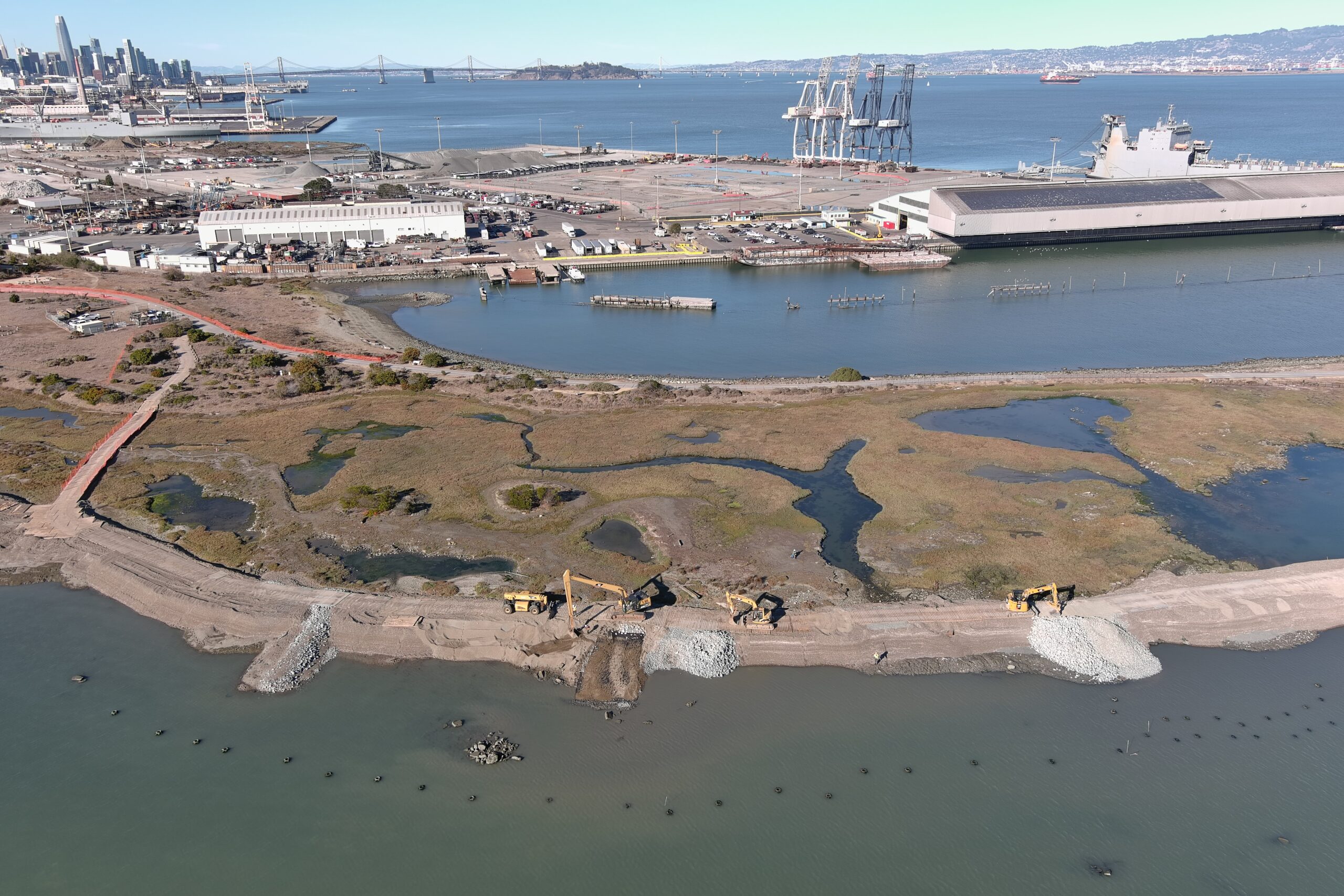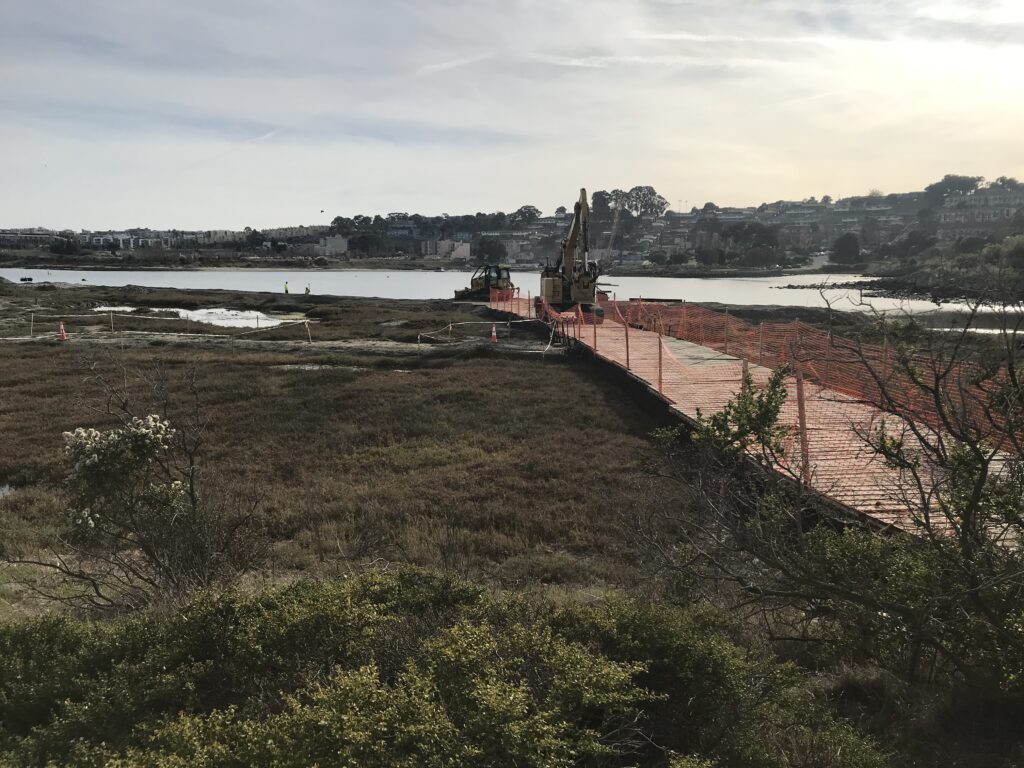
Carol Bach, who oversaw the restoration of a sliver of tidal wetlands on San Francisco’s industrialized shore in 1999, was alarmed to see her work eroding away decades later. Waves crossing the Bay from Hayward to Heron’s Head steadily carved away at this small peninsula of tidal habitat and public park favored by locals with few other options for waterfront recreation. The erosion was hard to miss: steep escarpments developed along the shore; the size of the marsh shrank; a tidal pool favored by shorebirds breached and became an embayment.
“We wanted to stop the erosion, restore the tidal pond, and protect the whole landscape using natural infrastructure,” says Bach, who stuck around long enough at the Port to fix the problem 20 years later. “But we couldn’t go with a green-only, vegetation-only shoreline resilience solution; the erosive forces at the site were too strong.”
Adds Eddie Divita, an engineer with Environmental Science Associates who helped design the project, “The landscape at Heron’s Head is strange, it’s not a natural form but a peninsula constructed out into the Bay with no local sediment supply. Our design goal was shoreline protection that would last 30 years.”
Their solution—incorporating coarse beach, two groins, three headlands perpendicular to the shore, 60 subtidal oyster reef balls, and a resilient coastal plant species called seablite—is a grey-green mix of infrastructure that showcases critical options for many eroding sites along the bayshore as sea level rises. “The idea is a vegetated beach protecting interior wetlands,” says Bach.
A centerpiece of the design is a two-part beach. On the east end farthest out in the Bay, where the waves roll in, lies a “feeder beach.” This beach offers a long-term local supply of coarse gravel to the second beach farther inland. (Managers even sourced the material from adjacent Martin Marietta, a sand-mining operation.)
“With constructed beaches, there’s often a maintenance problem,” says Divita. “If there is no natural sediment supply the beach washes away, especially if it’s at an angle relative to incoming waves like this one.”

The port completed construction of the project in December 2022, just before the first round of atmospheric river storms over the holidays. “When that storm train arrived, I had many sleepless nights worrying it would wash all our work away,” says Bach. But to her delight, the project elements—beach, groins (barriers made of bigger rocks), headlands (barriers made of smaller rocks), a fortified tidal pool—performed exactly as designed.
“In early pictures, the groins look like big ugly scars, but after the first heavy-duty storms the coarse beach material washed east to west over them and now they look more natural. It held up really well in extreme weather,” says Bach.
“We wanted to make sure that we had enough speed bumps to keep the gravel on the beach during storms and for a longer period of time,” says Divita. Subsequent storms and large waves proved how dynamic their nature-based design could be: “The waves pushed the gravel up the beach slope, actually helping to build up the beach, instead of eroding the tidal marsh.”
The original design included five groins made of rip rap and football-size cobbles, and 100 oyster reef balls. But the San Francisco Bay Conservation and Development Commission, which regulates fill of the Bay, didn’t like the footprint. As the project made its way through the regulatory approvals process—the third to use the newly improved and more coordinated process called BRITT—three of the groins became smaller “headlands” and the number of reef balls shrank to 60.
“As built there are not enough oyster reef balls to act as offshore erosion control, but enough to serve as habitat for oysters,” says Bach. One promising aspect, however, is that the Heron’s Head oyster population is expected to be less susceptible to die-offs from excessive freshwater outflows from the upper Estuary. As such it can provide a more resilient source of seed oysters for the Bay in general.
Though the regulatory approvals took 1.5 years to acquire, crews from contractor Dixon Marine built the project itself in just under four months. Bach calls this “miraculous,” given the limitations on which months and times of day and tidal windows in which they could work, driven by endangered species protections and access requirements for big equipment.
“Heron’s Head is a unique example of nature-based solutions to sea-level rise, including both habitat and rip rap,” says Bach. “We need a lot of tools in our adaptation tool box. Not every tool will work in every shoreline.”
This shoreline has another special asset: youth from Bayview-Hunter’s Point worked as eco-apprentices to grow the seablite in a nursery and plant it on the high beach elevations. “Unlike many wetlands, Heron’s Head is very visible to people,” Bach says. “It’s a place where lots of people can do hands-on restoration.”
Top Photo: Construction of groins and headlands at Heron’s Head in November 2022. Photo: Port of SF